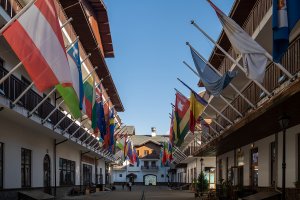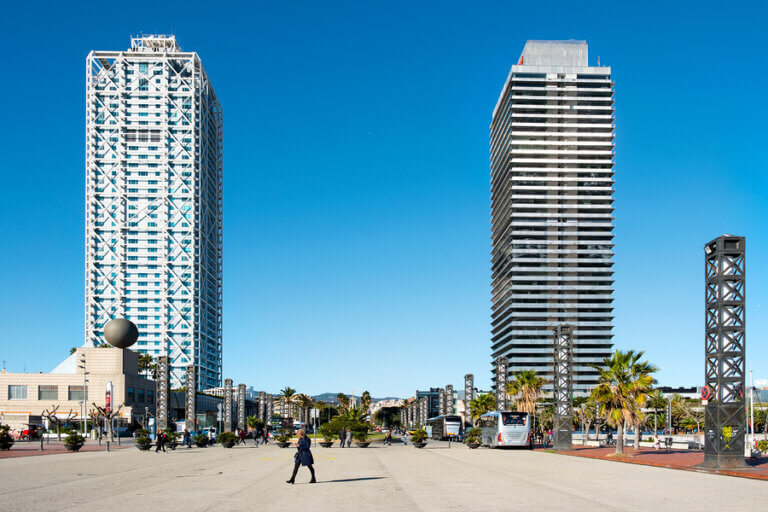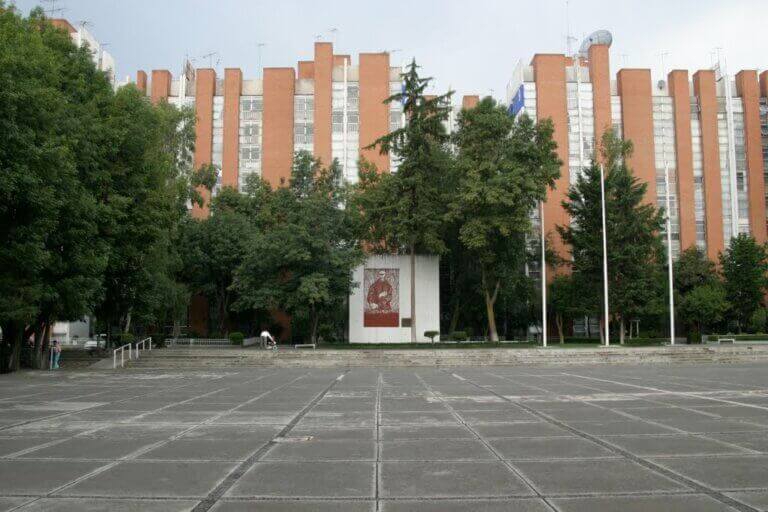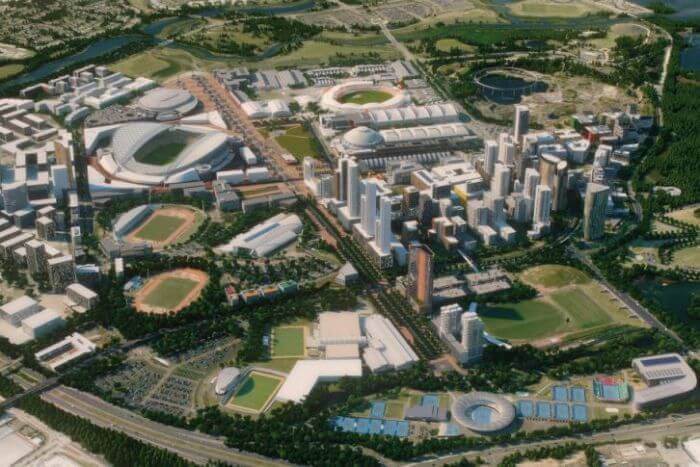Fate of The Olympic Villages: Where are They Now?

Every time a country hosts an Olympic game, they build complete “cities”. Athletes and their teams will live there during the games. These Olympic villages are sometimes wonderful works of art.
Then, once the sporting event is over, some are forgotten and others are sold as homes for local people. In this article, we’ll cover what happened to some of them.
But first, let’s cover the basics:
What are the Olympic villages?
Simply put, an Olympic village is an installation created to house the athletes, teams, and coaches who participate in any given Olympic Games. Of course, these villages are more than just homes. An Olympic village consists of different spaces: rooms of course, but also restaurants, shopping centers, and outdoor spaces.
In the first editions of the Games, each Olympic committee had to rent the property that their athletes would use, near the competition venues. However, for the Paris Olympic games of 1924, this situation changed. The organizers built cabins near to the Olympic stadium, in order to reduce traveling time for the athletes.
The Olympic village as we know it today had its ‘inauguration’ at the Berlin Games 1936. This complex consists of a set of buildings with rooms and other basic amenities for the athletes to use during the competitions. The first time this denomination was used was in Melbourne 1956.
What was the fate of the Olympic villages?
Many of the Olympic villages were in use even after the games were over. On the other hand, others were abandoned and are currently in a state of destruction. To avoid waste, the last few Olympic villages already had a plan for after the games when they designed them.
1. Berlin Olympic Village, 1936
This Olympic village west of the city had 145 rooms in buildings with up to two floors, a sports arena, a theater, a hospital, a sauna, and a swimming pool. This enclosure showed how ostentatious Nazi Germany was. It’s impressive they built this building amid WW2.

Image: Infinite Destination.
Shortly after finishing the Games, the local army used the facilities as command headquarters to delineate their combat strategies. Currently, this German village is an old construction, abandoned and without any purpose.
2. Olympic Village of Barcelona, 1992
This village is located in the district of Sant Marí (Poblenou) and was built for the athletes of the 1992 Barcelona Games. Alongside building the village, that area of the city began a project to modernize the neighborhood.

Sant Marí neighborhood is currently mainly residential. Nowadays, it has homes, schools, libraries, a port, a shopping center, a church, and a primary care center. To get to the Olympic village of Barcelona, you can take the subway or tram.
3. Olympic Village of Mexico, 1968
Built during 1968 to accommodate athletes, federation officials and foreign press, it had an initial area of nine hectares. Afterwards, they added 20 thousand square meters to the complex. Because it’s located on volcanic rock, this Olympic village could be destroyed in the event of an eruption.

Image: Urban Center.
This is a very complete Olympic village. Because of this, sports facilities in the village included a plaza, a bus stop, Olympic crafts, outdoor gyms, shopping areas, dining rooms, press areas, and training areas.
Since the beginning of construction, the government announced the plans for the complex. In fact, they said the 904 departments of this condominium – 29 towers – would be sold after the games were over. And that’s exactly what they did!
4. Olympic Village of Athens, 2004
Greece is the place where the Olympic Games were born, and that’s why Pierre de Coubertin decided that the first edition of the Olympics would take place in Athens.
Then, Athens repeated as the host in 2004. Of course, the government incurred great expenses to build top-of-the-line stadiums and facilities. The Olympic village was no exception.
Nevertheless, after the development of the sporting event with more than 10,000 athletes, the government forgot about the town. This was mainly due to the country’s economic and political problems.
5. Sydney 2000, one of the more innovative Olympic Villages
The Olympic Games that opened the millennium traveled to Oceania for the first time in history. The village built by Australians is, so far, the largest and with the latest technology of them all.

Image: ABC.
Of course, the building had a purpose after the games. The government decided to turn it into a residential complex, called Sydney Olympic Park (photo).
Finally, it’s important to mention the Olympic Village in London. The architect Zaha Hadid designed this wonderland. She also proposed a project to design the Tokyo Olympic Stadium, although she didn’t win on that occasion.
Every time a country hosts an Olympic game, they build complete “cities”. Athletes and their teams will live there during the games. These Olympic villages are sometimes wonderful works of art.
Then, once the sporting event is over, some are forgotten and others are sold as homes for local people. In this article, we’ll cover what happened to some of them.
But first, let’s cover the basics:
What are the Olympic villages?
Simply put, an Olympic village is an installation created to house the athletes, teams, and coaches who participate in any given Olympic Games. Of course, these villages are more than just homes. An Olympic village consists of different spaces: rooms of course, but also restaurants, shopping centers, and outdoor spaces.
In the first editions of the Games, each Olympic committee had to rent the property that their athletes would use, near the competition venues. However, for the Paris Olympic games of 1924, this situation changed. The organizers built cabins near to the Olympic stadium, in order to reduce traveling time for the athletes.
The Olympic village as we know it today had its ‘inauguration’ at the Berlin Games 1936. This complex consists of a set of buildings with rooms and other basic amenities for the athletes to use during the competitions. The first time this denomination was used was in Melbourne 1956.
What was the fate of the Olympic villages?
Many of the Olympic villages were in use even after the games were over. On the other hand, others were abandoned and are currently in a state of destruction. To avoid waste, the last few Olympic villages already had a plan for after the games when they designed them.
1. Berlin Olympic Village, 1936
This Olympic village west of the city had 145 rooms in buildings with up to two floors, a sports arena, a theater, a hospital, a sauna, and a swimming pool. This enclosure showed how ostentatious Nazi Germany was. It’s impressive they built this building amid WW2.

Image: Infinite Destination.
Shortly after finishing the Games, the local army used the facilities as command headquarters to delineate their combat strategies. Currently, this German village is an old construction, abandoned and without any purpose.
2. Olympic Village of Barcelona, 1992
This village is located in the district of Sant Marí (Poblenou) and was built for the athletes of the 1992 Barcelona Games. Alongside building the village, that area of the city began a project to modernize the neighborhood.

Sant Marí neighborhood is currently mainly residential. Nowadays, it has homes, schools, libraries, a port, a shopping center, a church, and a primary care center. To get to the Olympic village of Barcelona, you can take the subway or tram.
3. Olympic Village of Mexico, 1968
Built during 1968 to accommodate athletes, federation officials and foreign press, it had an initial area of nine hectares. Afterwards, they added 20 thousand square meters to the complex. Because it’s located on volcanic rock, this Olympic village could be destroyed in the event of an eruption.

Image: Urban Center.
This is a very complete Olympic village. Because of this, sports facilities in the village included a plaza, a bus stop, Olympic crafts, outdoor gyms, shopping areas, dining rooms, press areas, and training areas.
Since the beginning of construction, the government announced the plans for the complex. In fact, they said the 904 departments of this condominium – 29 towers – would be sold after the games were over. And that’s exactly what they did!
4. Olympic Village of Athens, 2004
Greece is the place where the Olympic Games were born, and that’s why Pierre de Coubertin decided that the first edition of the Olympics would take place in Athens.
Then, Athens repeated as the host in 2004. Of course, the government incurred great expenses to build top-of-the-line stadiums and facilities. The Olympic village was no exception.
Nevertheless, after the development of the sporting event with more than 10,000 athletes, the government forgot about the town. This was mainly due to the country’s economic and political problems.
5. Sydney 2000, one of the more innovative Olympic Villages
The Olympic Games that opened the millennium traveled to Oceania for the first time in history. The village built by Australians is, so far, the largest and with the latest technology of them all.

Image: ABC.
Of course, the building had a purpose after the games. The government decided to turn it into a residential complex, called Sydney Olympic Park (photo).
Finally, it’s important to mention the Olympic Village in London. The architect Zaha Hadid designed this wonderland. She also proposed a project to design the Tokyo Olympic Stadium, although she didn’t win on that occasion.
All cited sources were thoroughly reviewed by our team to ensure their quality, reliability, currency, and validity. The bibliography of this article was considered reliable and of academic or scientific accuracy.
- La Villa Olímpica de Tokio tendrá camas hechas de cartón. Enero 2020. Infobae. https://www.infobae.com/america/agencias/2020/01/09/la-villa-olimpica-de-tokio-tendra-camas-hechas-de-carton/
- Noticias y Protagonistas. Histórico: el COI se asocia con Airbnb y elimina la Villa Olímpica por U$S 500 millones. Noviembre 2019. https://noticiasyprotagonistas.com/actualidad/historico-el-coi-se-asocia-con-airbnb-y-elimina-la-villa-olimpica-por-us-500-millones/
This text is provided for informational purposes only and does not replace consultation with a professional. If in doubt, consult your specialist.








